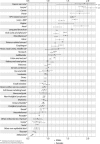The relationship between area poverty rate and site-specific cancer incidence in the United States
- PMID: 24866103
- PMCID: PMC4232004
- DOI: 10.1002/cncr.28632
The relationship between area poverty rate and site-specific cancer incidence in the United States
Abstract
Background: The relationship between socioeconomic status and cancer incidence in the United States has not traditionally been a focus of population-based cancer surveillance systems.
Methods: Nearly 3 million tumors diagnosed between 2005 and 2009 from 16 states plus Los Angeles were assigned into 1 of 4 groupings based on the poverty rate of the residential census tract at time of diagnosis. The sex-specific risk ratio of the highest-to-lowest poverty category was measured using Poisson regression, adjusting for age and race, for 39 cancer sites.
Results: For all sites combined, there was a negligible association between cancer incidence and poverty; however, 32 of 39 cancer sites showed a significant association with poverty (14 positively associated and 18 negatively associated). Nineteen of these sites had monotonic increases or decreases in risk across all 4 poverty categories. The sites most strongly associated with higher poverty were Kaposi sarcoma, larynx, cervix, penis, and liver; those most strongly associated with lower poverty were melanoma, thyroid, other nonepithelial skin, and testis. Sites associated with higher poverty had lower incidence and higher mortality than those associated with lower poverty.
Conclusions: These findings demonstrate the importance and relevance of including a measure of socioeconomic status in national cancer surveillance. Cancer 2014;120:2191-2198. © 2014 The Authors. Cancer published by Wiley Periodicals, Inc. on behalf of American Cancer Society.
Keywords: health disparities; incidence; poverty; socioeconomic status; surveillance.
© 2014 The Authors. Cancer published by Wiley Periodicals, Inc. on behalf of American Cancer Society.
Figures


Comment in
-
Poverty and lung cancer incidence.Cancer. 2014 Dec 15;120(24):4007-8. doi: 10.1002/cncr.28960. Epub 2014 Aug 5. Cancer. 2014. PMID: 25100185 No abstract available.
References
-
- Syme SL. Reducing racial and social-class inequalities in health: the need for a new approach. Health Aff (Millwood) 2008;27:456–459. - PubMed
-
- McLaren G, Bain M. Deprivation and Health in Scotland: Insights from NHS Data. Edinburgh, UK: Information Statistics Division, National Health Service in Scotland; 1998.
-
- Adler NE, Boyce WT, Chesney MA, Folkman S, Syme LS. Socioeconomic inequalities in health: no easy solution. JAMA. 1993;269:3140–3145. - PubMed
-
- Sidorchuk A, Agardh EE, Aremu O, Hallqvist J, Allebeck P, Moradi T. Socioeconomic differences in lung cancer incidence: a systematic review and meta-analysis. Cancer Causes Control. 2009;20:459–471. - PubMed
Publication types
MeSH terms
Grants and funding
LinkOut - more resources
Full Text Sources
Other Literature Sources

